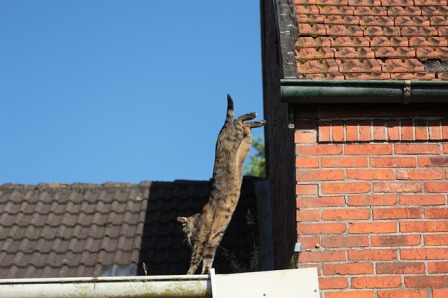Why Do Cats Land on Their Feet?
Why Do Cats Land on Their Feet?
During their lives in the wild, cats developed unique way to survive – hiding from danger in high places. They could not rely on strength, speed, or some other skill many other animals have in wild. Mother Nature granted cats with a specific mechanism that helped them to survive frequent falls when hiding from attack or any dangerous animal. Ages of adaptation on wildlife perfected cats physical mechanism and enabled them to rich a high percentage rate of survival when falling from high. This mechanism is, in fact, an inbuilt ability to maintain their balance during a fall. They cannot learn this from their mother. They simply instinctively know how to align their body in order to land on their feet. Even kittens that are about 6 weeks old know how to jump and correct their little bodies in the coordinated and balanced way. The article “Do Cats Always Land on Their Feet? “explains how cats physical mechanism works when the cat is trying to land on its feet.
Why Do Cats Land on Their Feet?
The physics of a falling feline
French scientist Etienne Jules Marey tested the reflex in 1890 by dropping a cat and using his chronophotographic camera to capture up to 60 consecutive frames a second of the cat’s fall. Afterward, he was able to watch in slow motion how the cat began to shift its balance the second the fall began.A vestibular apparatus in a cat’s inner ear acts as its balance and orientation compass so that it always knows which way is up. Once a falling feline has determined which part of its body should be facing up, it rotates its head to see where it’s going to land.
Next, the cat’s spine comes into play. Cats have a unique skeletal structure consisting of no collarbone and an unusually flexible backbone with 30 vertebrae (humans have 24). A feline’s backbone allows it to correct its position during freefall.
As its back arches, the cat positions its front feet under him with the front paws close to the face to protect it from impact. When he lands, the leg joints bear the weight of the impact.
Like flying squirrels, cats have a low body-volume-to-weight ratio, which allows them to slow their velocity when falling.
From the place where they are standing, cats do not always estimate actual height correctly, in spite of their gift or maybe just because of it. Not only they evaluate their position poorly, but also think that they can fly. As determined and focused hunters, cats become easily attracted to any bird or moving animal, which made their estimation vulnerable and exposed them to an incorrect decision – to jump, not properly considering their physical coordinates. It is the biggest temptation that undermines generally accepted statement that cats always land on their feet. Moreover, a phenomenon known as high-rise syndrome shows that cats falling from greater heights have more chance to survive than falling from lesser ones. Thus, falling from the first floor of the building can be fatal for a cat. In lesser heights, cats do not have enough time to align their body and find the correct posture to land safely. Understanding this, can help us to provide our cats with better care and prevent them from injuries.










